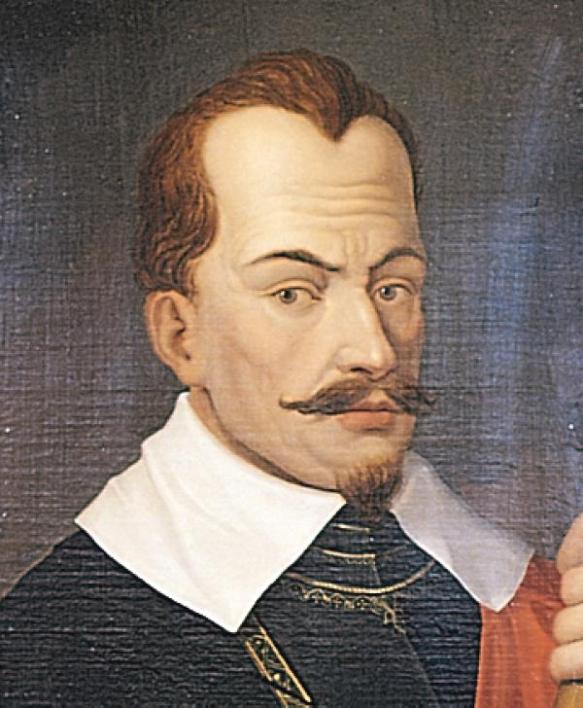
The Emperor again ordered Wallenstein’s dismissal in January 1634 and, to prevent betrayal, ordered loyal officers to imprison him and bring him to Vienna, or if necessary, to kill him. Worn down by illness and enmeshed in the tangle of his own conspiracies, Wallenstein could not complete his negotiations with his former enemies before he was caught by officers loyal to the Emperor at the fortress of Eger in Bohemia. These officers shot Wallenstein on the night of Feb. 25, 1634.
The Bohemian soldier of fortune Albrecht Wenzel Eusebius von Wallenstein (1583-1634) was one of the major figures in the Thirty Years War. His administrative and financial talents made him one of the richest and most powerful men in Europe.
Albrecht von Wallenstein was born on Sept. 24, 1583, at Hermanitz in Bohemia of noble family. Reared in the Utraquist (Protestant) faith, he converted to Catholicism before 1606 and attached himself to the court of the Hapsburg archduke (later emperor) Matthias, with whom he shared a strong interest in astrology. Marriage with a rich widow in 1609 added large Moravian estates to his possessions.
In 1618, when the Protestant Bohemian nobles rebelled against Matthias’s aggressively pro-Catholic successor, Ferdinand II, Wallenstein remained loyal to the Hapsburgs. Although he did not participate in their decisive victory in 1620 near Prague, wholesale confiscation of rebel property enabled him to purchase the vast estates of Reichenberg and Friedland. By 1622 he was one of the largest landholders in the kingdom, a status Ferdinand II recognized in 1624 by granting him the title Duke of Friedland. Wallenstein’s second marriage, in 1623 to Isabella von Harrach, brought him into the Emperor’s most intimate circle.
Wallenstein’s astonishingly rapid acquisition of enormous wealth and influence resulted from his ability to grasp every possible advantage from a political system dependent on mercenary armies. From the beginning, he organized his own estates to provide recruiting areas and supporting industries for equipping his regiments, whose services he offered at great profit. He was coldly calculating, shrewdly acquisitive, and enormously ambitious. But his talents as a commander in the field were mediocre.
Wallenstein was named imperial commander against the allied Protestant German and Danish forces in 1625. His first campaigns were disappointing in spite of the astonishing speed he had shown in raising and equipping the army. In 1627, with larger forces at his disposal, he swept the Danes out of Silesia and northern Germany, and by 1629 the Emperor could impose peace on Germany. Wallenstein’s price for his services included payment of his debts, large new grants of land, and the duchy of Mecklenburg, this last making him a sovereign prince of the empire.
Overestimating the security of his position in Germany, Ferdinand II dismissed Wallenstein from command in 1630. The Swedish invasion of the same year, however, undid the earlier victories, and Ferdinand II again had to call on Wallenstein’s services. The Emperor was at his general’s mercy, and the price was exorbitant. The terms of their agreement are still a mystery, but they included, in addition to money and new estates, virtual independence from political or religious interference in territories won back from the Protestant forces. Wallenstein began his last campaign in 1632 by driving the Saxons from Bohemia and then forcing Gustavus II (Gustavus Adolphus) to withdraw from Bavaria. On Nov. 16, 1632, the Swedish army struck Wallenstein’s forces at Lützen. Wallenstein withdrew from the field, abandoning his artillery, but Gustavus himself was killed, and the Swedish army retired leaderless.
Wallenstein had been incredibly lucky, and at this point he contemplated using his unprecedented powers as commander in chief to impose a peace on Germany with terms which fell far short of fulfilling Ferdinand’s own policies. Wallenstein’s own intentions are unfathomable, but both sides feared him as both competed for his allegiance. It is quite possible that he hoped to gain the Bohemian crown for himself. Whatever his motives were, he had decided by the end of 1633 to break with Ferdinand II, and he began negotiating with the Protestant princes. The Emperor again ordered Wallenstein’s dismissal in January 1634 and, to prevent betrayal, ordered loyal officers to imprison him and bring him to Vienna, or if necessary, to kill him. Worn down by illness and enmeshed in the tangle of his own conspiracies, Wallenstein could not complete his negotiations with his former enemies before he was caught by officers loyal to the Emperor at the fortress of Eger in Bohemia. These officers shot Wallenstein on the night of Feb. 25, 1634.
Further Reading The two standard works on Wallenstein are in German. The best study in English remains Francis Watson, Wallenstein: Soldier under Saturn (1938). Extensive material on Wallenstein is in Cicely Veronica Wedgwood, The Thirty Years War (1939). Additional Sources Liddell Hart, Basil Henry, Sir, Great captains unveiled, New York: Da Capo Press, 1996. Mann, Golo, Wallenstein, his life narrated, New York: Holt, Rinehart and Winston, 1976.